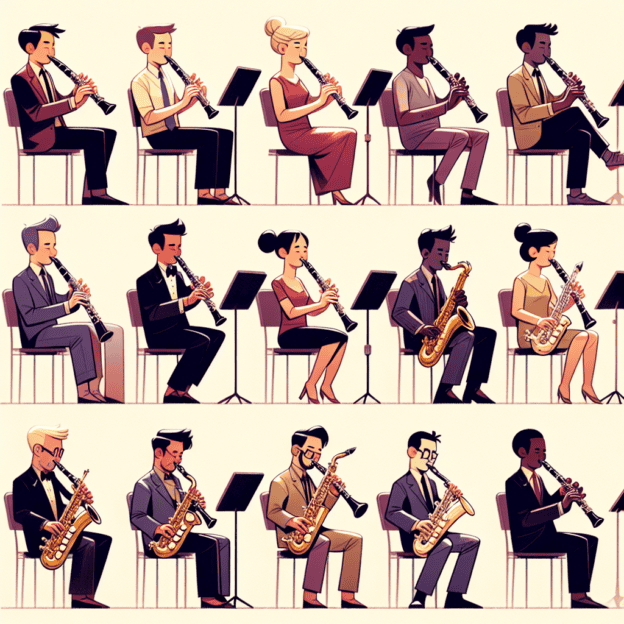The clarinet is a versatile instrument known for its wide breadth of sound and expressive capabilities. One of the most significant characteristics that define a clarinet's identity is its range. From the deep, resonant tones of the bass clarinet to the bright and clear sounds of the E-flat sopranino clarinet, understanding the range of each type of clarinet helps musicians express themselves better and enhances their overall playing experience. In this guide, we'll explore the various clarinet types, their unique ranges, and some interesting facts about how to make the most of your playing within each range.
Types of Clarinets and Their Ranges
Clarinets come in various sizes and pitches, each with its own unique range. Let's take a closer look at the most common types of clarinets:
| Clarinet Type | Written Range | sounding range |
|---|---|---|
| Bb Clarinet | E3 – C7 (and beyond) | D3 – Bb6 (and beyond) |
| A Clarinet | E3 – C7 (and beyond) | C#3 – A6 (and beyond) |
| Eb Alto Clarinet | Eb3 to G6 | G2 to Bb5 |
| Bass Clarinet | C3 – E6 | Bb1 – D5 |
| Eb Soprano Clarinet | G3 – C7 (and beyond) | Bb3 – Eb7 (and beyond) |
| Contra-Bass Clarinet | C3 – G5 | Bb0 – F3 |
Bb Clarinet
The Bb clarinet is the most widely used member of the clarinet family and a staple in concert bands, orchestras, and jazz ensembles. It has a bright, flexible tone suited for a wide variety of musical styles. The typical written range extends from E3 to C7, though advanced players can reach even higher into the altissimo register.
A Clarinet
The A clarinet is nearly identical in appearance and fingering to the Bb clarinet but is primarily used in orchestral and chamber music, especially in classical works. It has a slightly warmer, darker tone. Its written range is similar, typically from E3 to C7, with advanced players able to access altissimo notes beyond this range. Orchestral clarinetists often carry both A and Bb instruments.
Eb Alto Clarinet
The Alto clarinet is pitched in Eb, between the soprano clarinets (Bb and A) and the bass clarinet. It has a warm, rounded tone and is commonly used in concert bands and clarinet choirs, though rarely found in orchestral music. Its typical written range is from Eb3 to G6, with some models extending lower to C3. The alto clarinet transposes up a major sixth, meaning written C sounds as Eb. It bridges the tonal gap between the upper and lower voices in clarinet ensembles.
Bass Clarinet
The bass clarinet adds depth and richness to the clarinet family with its deep, mellow tone. Standard models have a written range from Eb3 to E7, while professional models with an extended bell can reach down to C3. It is commonly used in symphonic music, wind ensembles, and contemporary compositions.
Eb Soprano Clarinet
The Eb soprano (sopranino) clarinet is a smaller, higher-pitched instrument known for its bright, penetrating sound. It is often featured in orchestral and wind band music for technical or ornamental passages. Its written range typically spans from G3 to A6, though advanced players may extend beyond this.
Contra-Bass Clarinet
The contrabass clarinet is the largest and lowest member of the clarinet family. It is capable of producing deep, resonant tones that provide foundational support in large ensembles such as symphonic bands and clarinet choirs. Its written range generally extends from Eb3 to A6, with professional models reaching as low as C3.
Maximizing Your Clarinet's Range
Now that we have a clearer idea of the ranges of various clarinets, let's discuss strategies to help maximize your playing within these ranges:
1. Breath Control
Good breath support is key for playing across the full range of your clarinet. Practice long tones, focusing on maintaining consistent airflow and pressure. This will help stabilize your sound in both low and high registers.
2. Finger Coordination
Finger technique is important for quickly hitting high or low notes. Finger coordination exercises, such as scales and arpeggios, can improve speed and accuracy. Include finger drills that focus on alternative fingerings to enhance your technique and fluidity.
3. Understanding Clarinet Registers
The clarinet has three main registers: the chalumeau (low), the clarion (mid), and the altissimo (high). Get to know the fingerings and tonal qualities unique to each register. Practice moving smoothly between registers to improve your overall sound and performance.
4. Use of Overtones
Learning overtones, or harmonics, can also help you explore your instrument's range. By practicing overtones, you'll develop better control over your embouchure, air support, and overall tonal quality.
Interesting Facts about Clarinet Ranges
- The clarinet uses a single reed. This is a design it shares with the saxophone, which contributes to its unique sound and wide expressive range.
- Melodic Capabilities. The ability of clarinets to move through various ranges allows musicians great flexibility in both orchestral settings and solo performances, making it a versatile choice for any genre.
- Early Construction: Historical clarinets were often limited in their range compared to modern designs; advancements in key systems and bore design have greatly expanded the potential for clarinetists today.
In summary, understanding the different ranges of clarinets can enhance your playing experience and improve your musical performance. Whether you are a beginner just starting your journey or an experienced player looking to refine your skills, knowledge about the clarinet's range is fundamental to becoming an accomplished musician. By incorporating breath control exercises, finger coordination drills, and becoming acquainted with clarinet registers, you'll find yourself expressing your musical ideas with greater ease and confidence.







